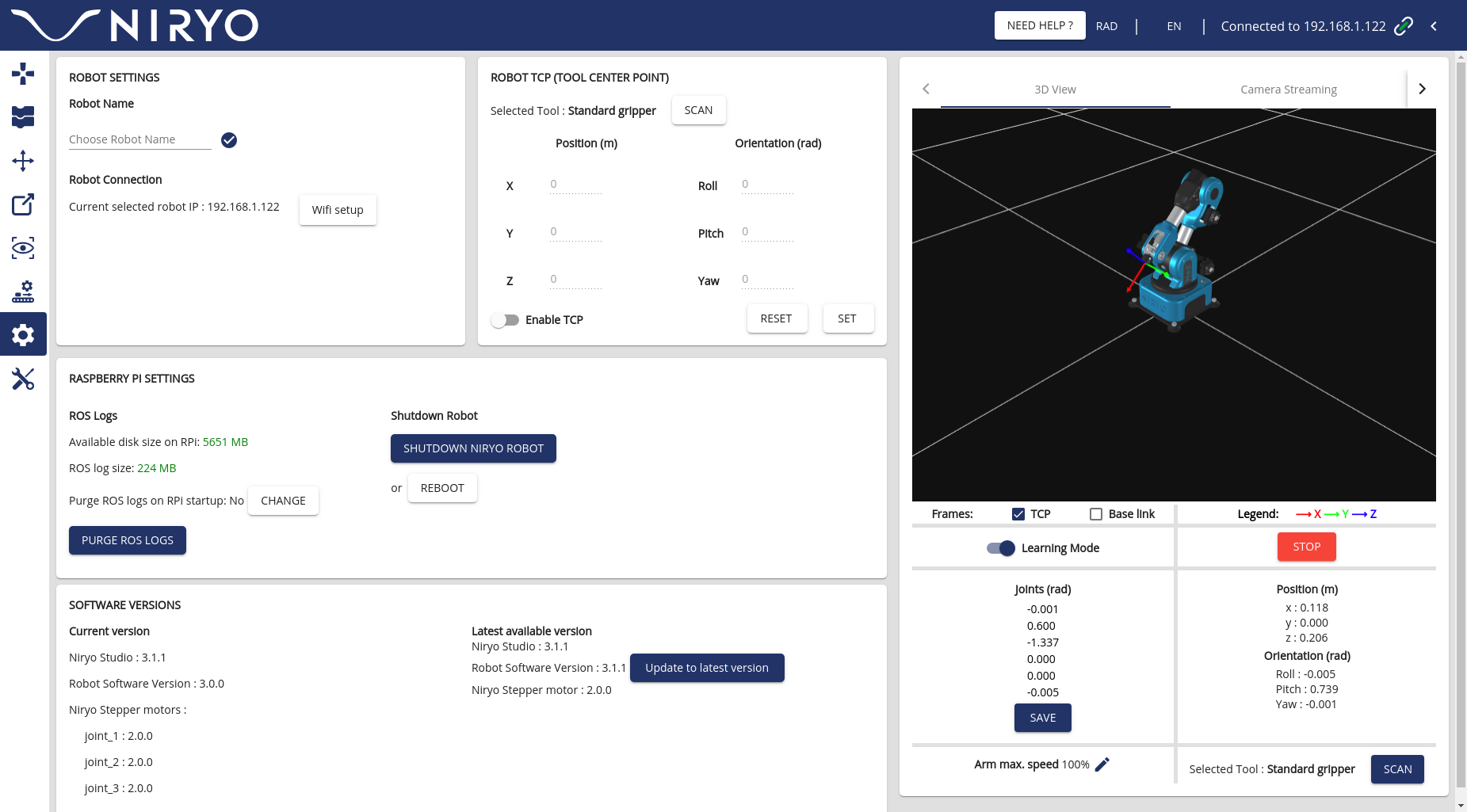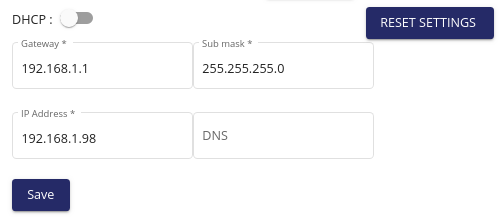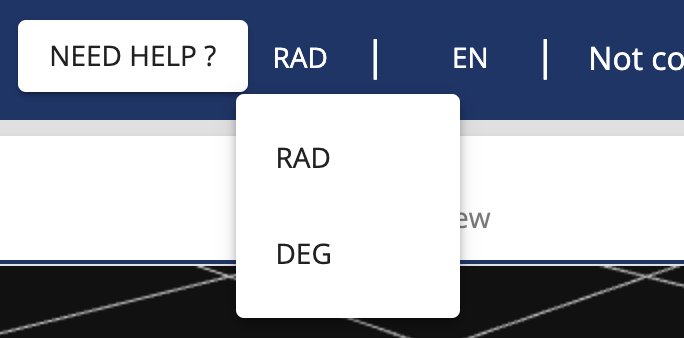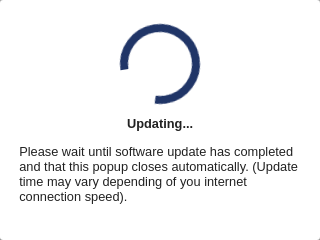Robot’s settings and update¶
Ned settings¶
Ned’s related parameters can be set in the “ROBOT SETTINGS” panel.

Robot Name¶
You can give a custom name to Ned.
- This name will be used when Ned is in hotspot mode to create the Wi-Fi network name.
- In Niryo Studio, when Ned is in connected mode, you will see that Ned is represented both by its IP address and its custom name.
You can set a custom name under “ROBOT SETTINGS”. After choosing the name, you need to reboot Ned.
Robot TCP (Tool Center Point)¶
The TCP (Tool Center Point) of the robot corresponds to the working point of the tool. From here, you can change the frame of the TCP.

When the TCP is enabled, every position move is set corresponding to the TCP frame.
When you plug a tool and if the TCP is enabled, the TCP frame will automatically update to the corresponding tool TCP.
Ned Wi-Fi setting¶
If Ned is already connected to a Wi-Fi network and you want to change your Wi-Fi network:
- Connect to Ned in “Hotspot mode” or in “Connected mode”
Note
If you are not connected to Ned, you will not be able to change its Wi-Fi network.
Under “ROBOT SETTINGS”, check your current IP address.
Click the Wi-Fi setup button and fill in the Wi-Fi name (SSID) and password of the Wi-Fi network you want Ned to connect to. Make sure to avoid typos in the name and password. Then, click on “Connect robot to Wi-Fi”.
Ned will try to connect to the Wi-Fi, depending on the result, the robot’s reaction changes:
- If successfully connected: the robot will reboot itself, the LED will become red then green. Connect to the same wifi network and then connect to Ned (Help: Using Ned on your Wi-Fi network.)
- If failed to connect to the SSID: the LED will remain blue (the LED didn’t change after ~30 seconds). Verify your password and try to connect again.
- If the SSID can’t be found currently by the Raspberry Pi: you won’t be disconnected from Niryo Studio, but an error notification will be shown. You can retry within a few seconds (the wi-fi card may be disturbed by other wi-fi devices) or move your Raspberry Pi closer to the Wi-fi router.
Warning
If you changed Ned network configuration from Wi-fi to hotspot, troubles can occur when reconnecting via Niryo Studio, please reboot your robot in this case.
Network settings¶
If Ned you are connected to Ned, you have the possibility to modify these network settings:
- Go to settings section
Note
If you are not connected to Ned, you will not be able to change its network settings.

- Under “Robot Connection”, you can change network settings.
- With toggle button, you can activate or desactivate DHCP mode. This mode provides you with an automatic ip address.
- When click on “RESET SETTINGS” button, your Ned returns with the original network settings, i.e. with the ip address : 169.254.200.200
- If you desactivate DHCP mode, you can see a form appear to modify the network settings with this information
- Gateway
- Submask
- Ip address
- DNS
- When click on “Save” button, this information is saved in the Ned.
Warning
When you change the network settings, you will be automatically disconnected from the Ned. You will then have to reconnect with the new IP address of the Ned or search for the Ned again.
Language selection¶
The default language of Niryo Studio is English but you can change the current language with the language button on the top toolbar.

Note
The Blockly editor and the logs remain in English.
Angle unit selection¶
The default angle unit in robotics is radian. But you can change to degree with the corresponding button in the top toolbar.

Raspberry PI settings¶

ROS logs:
In this section, you can see:
- The available disk size on the Raspberry Pi. If the number is displayed in orange or red, it means there is no space enough on the micro-SD card.
- The size of the stored ROS logs: after some times, they can take a lot of space.
- You can choose to remove all previous ROS logs when Ned boots. This is very useful for a normal usage of Ned. Basically, you do not need all the ROS logs that are produced and stored, unless you are developing or debugging a specific point (in this case you might want to switch the option to “NO” and then turn it back to “YES” when you’re done).
Caution
If you never purge ROS logs (on boot or manually), the micro-SD card will eventually become full and might not work as expected. So only change the option to “NO” if you know what you are doing. In any case, if you do not really understand this functionality, always leave the option to “YES”.
- You can also remove all ROS logs immediately by clicking on the “Purge ROS logs” button.
- Shutdown Ned.

- You can shut down Ned with Niryo Studio. The “SHUTDOWN NIRYO ROBOT” will shut down the Raspberry Pi (same behaviour as if you press the physical top button for 3 seconds). Be sure to wait for the LED to turn red before completely powering off Ned.
- You can reboot Ned by clicking “Reboot”.
Note
If you reboot Ned, do not power it off. The LED will turn to purple, then red, then will become blue or green again.
Software versions¶
You can check that Ned and relative softwares are up to date by comparing the current and latest version for each of them.
- Niryo Studio: the desktop app to control Ned.
- Robot Software: the current version of the Niryo robot ROS stack running on Ned.
- Niryo Steppers motors: a list of the firmware versions running on each NiryoStepper attached to Ned. Click here to update the firmware version.
Note
All the NiryoStepper motors must have the same version.
- Latest available versions (directly updated from our website).
Note
If an incompatible software version is detected, if the version you have is not supported anymore or an update is available, you will get a pop-up notification when you connect to Ned. Please follow the displayed instructions.
|
a. Message displayed when Ned is not connected to internet. |
b. An update is available to update Ned software. |
Ned software Update¶
Ned software inside the robot can be updated through Niryo Studio in only a few steps.
First, your Ned must have an access to internet, so you have to connect it to an ethernet (you have to edit via ssh the network configuration of Ned) or a Wi-fi network that provides internet.
When your robot is properly configured, at the next boot of the robot, it will check if an update is available. A pop-up will then be displayed at each following connection from Niryo Studio with Ned to inform you that an update is available for your robot.
You then only have to click on the update button of the pop-up or the update button in the software versions panel.
Warning
Ned will reboot itself at the end of the process (in case of update success) so it’s recommended not to do any other operation with Ned before starting an update.
Once the update has started, a pop-up will indicate that Ned is updating and that it’s downloading / applying the update.

Note
Update time is heavily impacted by the internet speed of your connection so if you connect to a wi-fi network, be sure that the raspberry is not too far away from the wi-fi modem.
Once the update has successfully ended, another pop-up will appear (closing the previous one) telling that your robot will reboot and you may be disconnected from Niryo Studio. Now you just have to wait for the robot to initialize properly (the red LED turning into green or blue) before reconnecting through Niryo Studio, the update process is done.

Warning
In case the update failed, it could be a faulty connection, try to do the update once more and if you still encounter a problem, please contact us at contact@niryo.com.


